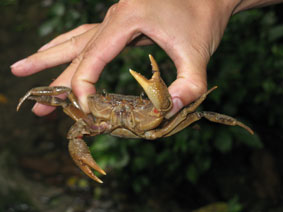The zooarchaeological component of the TAAP to date has been undertaken by Ryan Rabett (macro-vertebrate, and non-molluscan invertebrate fauna), Chris Stimpson (micro-vertebrate fauna) and Katherine Szabó (University of Wollongong) (molluscs), though their work has been assisted greatly by a number of other individuals, including Philip Piper (University of the Philippines), Darren Yeo and Tohru Naruse (University of Singapore), and personal communications from Torsten Blanck regarding turtle identification.
 The faunal resources exploited by people visiting Hang Boi comprised a range of terrestrial, arboreal and riverine species. Although this included a significant amount of freshwater animals (particularly freshwater crab), the procurement strategy did not involve the gathering of sufficient freshwater molluscs to have provided a significant number of calories; land snails dominate the large molluscan assemblage, which has been verified as largely, if not wholly, of anthropogenic in origin. The fact that only two species of land snail dominate the midden is further indication of deliberate selectivity on the part of foragers, given that these form one part of a comparatively wide variety of potential prey species present in the local landscape. Groups visiting the site were clearly targeting a range of different local forest and river habitats. Potentially they were practicing a subsistence strategy that centred upon reliable food staples that were available during periods of seasonal abundance, whilst taking other prey species on a more opportunistic basis. Of particular interest is the fact that, despite increasing proximity to the coastline, there is currently no evidence that marine resources featured in the diets of people when they were staying at the cave. Despite this, tentative evidence for some form of coastal link is indicated through the discovery of a fragment of cowry, a sea mollusc, at the site. While several hypotheses are being considered, it is certainly plausible that people were occupying Hang Boi on a seasonal basis, timed to coincide with peaks in local resources.
The faunal resources exploited by people visiting Hang Boi comprised a range of terrestrial, arboreal and riverine species. Although this included a significant amount of freshwater animals (particularly freshwater crab), the procurement strategy did not involve the gathering of sufficient freshwater molluscs to have provided a significant number of calories; land snails dominate the large molluscan assemblage, which has been verified as largely, if not wholly, of anthropogenic in origin. The fact that only two species of land snail dominate the midden is further indication of deliberate selectivity on the part of foragers, given that these form one part of a comparatively wide variety of potential prey species present in the local landscape. Groups visiting the site were clearly targeting a range of different local forest and river habitats. Potentially they were practicing a subsistence strategy that centred upon reliable food staples that were available during periods of seasonal abundance, whilst taking other prey species on a more opportunistic basis. Of particular interest is the fact that, despite increasing proximity to the coastline, there is currently no evidence that marine resources featured in the diets of people when they were staying at the cave. Despite this, tentative evidence for some form of coastal link is indicated through the discovery of a fragment of cowry, a sea mollusc, at the site. While several hypotheses are being considered, it is certainly plausible that people were occupying Hang Boi on a seasonal basis, timed to coincide with peaks in local resources.
 Last updated on 17/10/2012
Last updated on 17/10/2012
Information provided by Ryan Rabett


